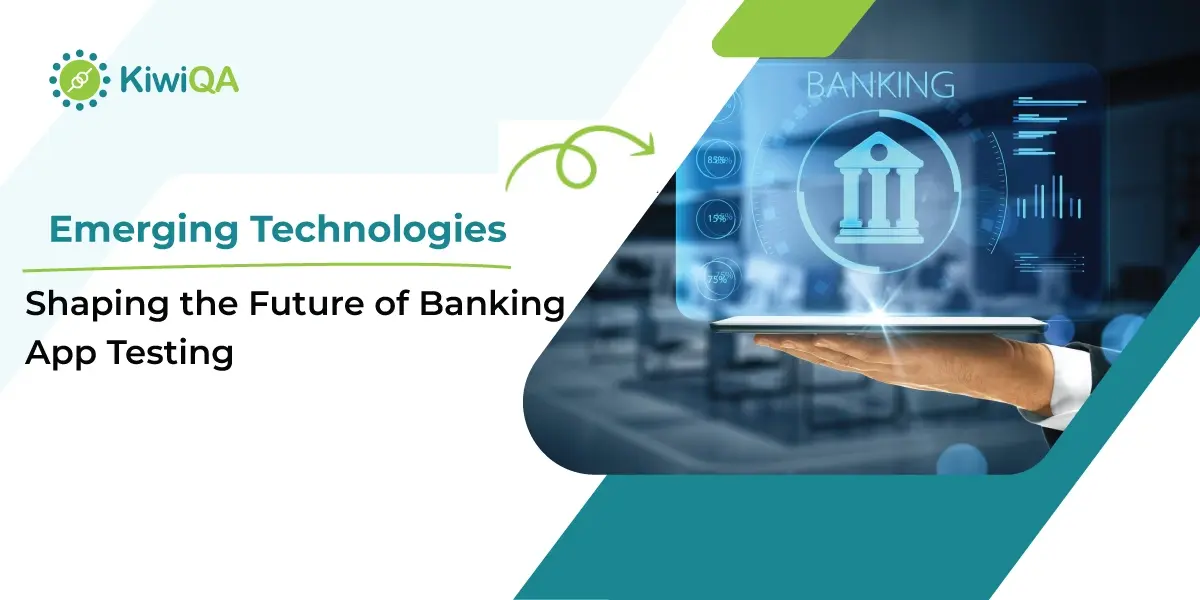Emerging Technologies Shaping the Future of Banking App Testing

 KiwiQA
KiwiQATable of Contents
Those days are gone when you wait in long queues to consult with a banking expert. With the fintech industry experiencing a surge in digital transformation efforts, the majority of financial institutions are embracing this significant shift, which enhances the collaboration between financial organizations and their customers.
With the advent of technologies like AI and Blockchain, the banking sector is now offering more convenient personalized experiences. These technologies are used in the testing phase to ensure app security and reliability. In this era of digital transformation, the banking sector is continually exploring innovative methods to improve customer satisfaction. From finance app testing to fraud detection services, with the help of digital solutions, the industry offers seamless, secure, and personalized experiences.
As per the recent market trends Statista reports, the global digital banking platform market size is expected to grow from USD 8.2 billion in 2021 to USD 13.9 billion by 2026, with an 11.3% growth CAGR. The reports also said that 2.5 billion individuals are expected to use online banking services by 2024. The advanced technologies in banking applications empower customers to get better control over their financial data.
Digital transformation in the banking sector harnesses cutting-edge digital tools and techniques to revamp and optimize the monetization and delivery of banking services. The banking apps require advanced technology with the aim to enhance customer experiences and generate new revenues, and operational efficiencies.
Advanced technology promotes innovative digital capabilities such as automation, personalization, & digitalization that drive your business growth & improve competitiveness.
As mobile usage skyrocketed, customers began to prefer receiving services through mobile devices in just one tap. The financial sector underwent a major transformation due to shifting customer preferences, compelling the banking industry to adjust or risk falling behind. As a result, banking institutions are now heavily investing in digital technologies to improve their customer service, as highlighted earlier.
Bank & financial organizations should ensure their apps are secure and safe. The banking application should perform its best and doesn’t compromise with the customer’s sensitive data. Online banking has improved the way customers interact with financial institutions. The shift towards digital channels fosters the banking experience.
Here we listed some best technologies for banking application security testing:
Artificial intelligence and machine learning are instrumental in driving the digital revolution within the banking sector. Banking institutions and financial firms are leveraging the technologies to automate repetitive tasks like account reconciliation & data entry to make wise decisions through predictive analytics.
AI-driven test automation improves efficiency and minimizes errors. Banking apps use AI & NLP (Natural language processing) to improve the chatbot for better interactions with the customer. AI testing offers personalized financial advice to enable them to develop an efficient and better customer service experience.
Transforming the regular banking experience & making it more engaging, convenient & personalized will be easy with the integration of VR and AR. Using AI banking institutions not only fosters customer engagement but it helps to improve your trust and customer satisfaction. AI testing offers interactive, immersive, and personalized experiences, whether in-branch remotely, to ultimately drive business growth.
The banking platform utilizes DLT technologies and Blockchain to secure financial transactions and to develop new services like smart contracts & digital identities. Blockchain technology works in the form of a decentralized nature that boosts the security of financial transactions & offers transparency for multiple parties who are involved.
In addition, Blockchain technology helps to develop net standards of trust in the financial ecosystem, which enables the development of new products development & services like cryptocurrency and digital assets that can be utilized for financial transactions & payments. Utilizing blockchain technology helps you to ensure authentication & data integrity.
Blockchain for security testing works in the following format- identifying the platform, critical test points, right testing tools, deploying tools & testing & stabilizing the application. Blockchain technology is considered as the future and that’s the reason why businesses are implementing this before the market launch.
The IoT testing aims to check IoT banking system efficiency, performance & safety. Banking apps use IoT devices for testing performance, how the system handles a wide amount of data, app security testing, IoT devices, and functional & integration testing specific to the architectures.
A single glitch in the app results in a cyberattack that degrades the quality of the organization. Robust IoT testing prevents unforeseen errors and system predictability. It enables the end-user to give an errorless customer experience. The IoT susceptibility evaluates the privacy and security of data. Hackers can take sensitive data in the absence of cybersecurity; this is the reason why extensive IoT testing is required before every upgrade.
The rise of IoT in the banking sector has been improved because of the data synchronization service & multiple device compatibility features. IoT devices enable banking applications to engage with customers more frequently and provide innovative services.
Collaborating banking services with wearables, like digital payments is another reason IoT is bringing banking institutions closer to their clients.
The cloud-based testing solution is another technology that plays a pivotal role in transforming the banking industry. The banking sector and financial institutions are now using cloud computing for storing & processing large amounts of data & running various applications to enable reduced costs and improved scalability & overall efficiency of IT systems.
By leveraging the Cloud, banks can access data from anywhere & at any time, leading to improved collaboration & agility that results in banking applications being more responsive to customer needs. The most common benefit of choosing cloud-based testing for banking apps are cost-effectiveness, scalability, and remote testing functionality.
Cloud computing empowers financial institutions to break free from non-essential tasks such as managing data centers and IT infrastructure, all while providing cost-effective access to computing services and adaptable storage solutions.
Integrating cloud-based testing solutions can improve the efficiency of application development and maintenance by 38% and improve infrastructure costs by 29%. Utilizing the Cloud-based technology solution in bank app testing allows them to utilize more flexible storage at a cheaper cost.
DevOps & continuous testing is the process of executing automated software tests on an application. Continuous testing aims to define the quality changes in the apps at every step of the software development process. Continuous testing works with the continuous deployment process to ensure the ongoing quality of coding pushed into the live production after each deployment iteration.
The continuous testing process works best for the processes that set a high level of code change and automation with minimal intervention of humans. Integrating DevOps practices into the banking app testing helps to achieve continuous testing and automation in every stage with seamless collaboration between testing and development teams. It ensures rapid delivery without compromising the app’s quality.
In the realm of DevOps, the objective is to find the optimal equilibrium among the objectives, feedback loops, quality assurance, operational teams, development expertise, and more. It promotes the collaboration of 3 teams when automating the software delivery process and changes in infrastructures.
These technologies are used for testing banking apps before their launch to ensure the app quality and user-friendliness. It ensures the app you are going to launch is top-notch in terms of security, safety, reliability, and user-friendliness.
Now, banks also realize that customers are expecting applications that must offer consistent and personalized experiences across all channels. Banks have provided overall experience and increased customer retention. Integrating VR & AR in banking apps for user experience testing can change the way banks interact with their customers.
Transforming the traditional banking experience & making it more engaging can be possible with the integration of AR & VR into their services. Both VR and AR go beyond simply boosting customer engagement; they also play a crucial role in fostering trust and elevating customer satisfaction by delivering interactive, immersive, and tailor-made experiences. VR & AR user experience testing ultimately drives the banking institution’s growth.
VR & AR testing in banking apps ensures a seamless & immersive user experience. Banking institutions use VR and AR for personal user experience to revolutionize the industry. AR & VR are used for making smart decisions. This technology helps financial organizations to improve their efficiency, increase their security & generate new revenue.
Performance testing & big data analytics testing for mobile banking applications ensure the app’s performance. The banking application has a wide number of performance criteria, which include connectivity, infrastructure int, integration with the backend, etc. The banking app transaction must be monitored at regular intervals & load/stress tests must be regularly performed to ensure support for multiple transactions at a given point in time.
Any performance-related failures in banking apps can cause serious damage to both end-user trust and end-user trust. Secure & smooth support for ease of access to transactions & performance is essential for the banking application to succeed. The application should meet the scalability goals to contribute to the business goals.
It is necessary to carry out big data analytics for performance testing & scalability to analyze and diagnose the app performance. The developers harness big data analytics performance testing for scalability testing, load testing, and predictive performance optimization.
Compliance testing evaluates whether the banking application fulfills the regulation & standard requirements, specifications, etc. The process can be considered as the auditing task to ensure that it will fulfill all the required standards. The regulatory compliance goal is to ensure the financial operation within regulation by considering the integrity & industry reputation.
Compliance and regulatory testing are done for multiple duties like bank data protection, avoiding tax government fines, and avoiding money laundering or tax evasion activities. It is used to assess the risks & ensure the non-violation of financial regulations & ethics. The regulatory conditions meet the complex aims by proactively measuring the strong policy to enforce the ethical banking culture & process standardization.
The banking institution performs this testing to ensure the app meets all the financial industry regulations. It ensures the application meets with the CCPA, ad GDPR, and other data privacy laws. Implementing automated regulatory testing also ensures app compliance and risk mitigation.
It has brought many benefits for the customers, which are increased speed, convenience, and accessibility. More financial institutions are implementing this testing to gain user trust and business credibility.
The rise of mobile banking is due to the high rise of mobile usage. Now every one of us wants to perform a transaction through phones, and that’s why mobile banking applications are gaining popularity. To improve the user experience and by considering their comfort, the banking & financial institutions began to invest in the digital technologies we mentioned above.
Banks had to ensure that the banking application they are offering is intuitive and offers a seamless and secure experience. To stay relevant in the industry, the banking software testing service is embracing its application with artificial intelligence, Blockchain, and IoT. This is how traditional banking is transforming itself from digital banking. The future trend of banking app technology is bright as the technology is rapidly evolving and opening the doors of new possibilities for financial industries.
Join the like-minded community & get the latest updates and insights on software testing technological transformation around the globe. Don't miss out.
